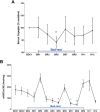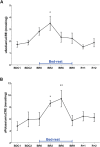Early Biomarkers of Altered Renal Function and Orthostatic Intolerance During 10-day Bedrest
- PMID: 35514354
- PMCID: PMC9065601
- DOI: 10.3389/fphys.2022.858867
Early Biomarkers of Altered Renal Function and Orthostatic Intolerance During 10-day Bedrest
Abstract
Exposure to actual or simulated microgravity results in alterations of renal function, fluid redistribution, and bone loss, which is coupled to a rise of urinary calcium excretion. We provided evidence that high calcium delivery to the collecting duct reduces local Aquaporin 2 (AQP2)-mediated water reabsorption under vasopressin action, thus limiting the maximal urinary concentration to reduce calcium saturation. To investigate early renal adaptation into simulated microgravity, we investigated the effects of 10 days of strict bedrest in 10 healthy volunteers. We report here that 10 days of inactivity are associated with a transient, significant decrease (day 5) in vasopressin (copeptin) paralleled by a decrease in AQP2 excretion, consistent with an increased central volume to the heart, resulting in reduced water reabsorption. Moreover, bedrest caused a significant increase in calciuria secondary to bone demineralization paralleled by a decrease in PTH. Urinary osteopontin, a glycoprotein exerting a protective effect on stone formation, was significantly reduced during bedrest. Moreover, a significant increase in adrenomedullin (day 5), a peptide with vasodepressor properties, was observed at day 5, which may contribute to the known reduced orthostatic capacity post-bedrest. We conclude that renal function is altered in simulated microgravity and is associated with an early increase in the risk of stone formation and reduced orthostatic capacity post-bedrest within a few days of inactivity.
Keywords: adrenomedullin; aquaporin-2 (AQP2); bedrest; calcium; copeptin; kidney; osteopontin; vasopressin.
Copyright © 2022 Tamma, Di Mise, Ranieri, Centrone, Venneri, D’Agostino, Ferrulli, Šimunič, Narici, Pisot and Valenti.
Conflict of interest statement
The authors declare that the research was conducted in the absence of any commercial or financial relationships that could be construed as a potential conflict of interest.
Figures






Similar articles
-
A decrease in aquaporin 2 excretion is associated with bed rest induced high calciuria.J Transl Med. 2014 May 19;12:133. doi: 10.1186/1479-5876-12-133. J Transl Med. 2014. PMID: 24885203 Free PMC article.
-
Effect of prolonged bedrest on the propensity for renal stone formation.J Clin Endocrinol Metab. 1988 Jan;66(1):109-12. doi: 10.1210/jcem-66-1-109. J Clin Endocrinol Metab. 1988. PMID: 3335600
-
Prevention of hypercalciuria and stone-forming propensity during prolonged bedrest by alendronate.J Bone Miner Res. 1995 Apr;10(4):655-62. doi: 10.1002/jbmr.5650100420. J Bone Miner Res. 1995. PMID: 7610938 Clinical Trial.
-
Dietary treatment of urinary risk factors for renal stone formation. A review of CLU Working Group.Arch Ital Urol Androl. 2015 Jul 7;87(2):105-20. doi: 10.4081/aiua.2015.2.105. Arch Ital Urol Androl. 2015. PMID: 26150027 Review.
-
A Minireview on Vasopressin-regulated Aquaporin-2 in Kidney Collecting Duct Cells.Electrolyte Blood Press. 2015 Jun;13(1):1-6. doi: 10.5049/EBP.2015.13.1.1. Epub 2015 Jun 30. Electrolyte Blood Press. 2015. PMID: 26240594 Free PMC article. Review.
Cited by
-
The kidney, volume homeostasis and osmoregulation in space: current perspective and knowledge gaps.NPJ Microgravity. 2023 Apr 1;9(1):29. doi: 10.1038/s41526-023-00268-1. NPJ Microgravity. 2023. PMID: 37005397 Free PMC article. Review.
References
-
- Armbrecht G., Belavý D. L., Gast U., Bongrazio M., Touby F., Beller G., et al. (2010). Resistive Vibration Exercise Attenuates Bone and Muscle Atrophy in 56 Days of Bed Rest: Biochemical Markers of Bone Metabolism. Osteoporos. Int. 21, 597–607. 10.1007/s00198-009-0985-z PubMed Abstract | 10.1007/s00198-009-0985-z | Google Scholar - DOI - DOI - PubMed
-
- Asplin J. R., Arsenault D., Parks J. H., Coe F. L., Hoyer J. R. (1998). Contribution of Human Uropontin to Inhibition of Calcium Oxalate Crystallization. Kidney Int. 53, 194–199. 10.1046/j.1523-1755.1998.00739.x PubMed Abstract | 10.1046/j.1523-1755.1998.00739.x | Google Scholar - DOI - DOI - PubMed
-
- Baecker N., Tomic A., Mika C., Gotzmann A., Platen P., Gerzer R., et al. (2003). Bone Resorption Is Induced on the Second Day of Bed Rest: Results of a Controlled Crossover Trial. J. Appl. Physiol. 95, 977–982. 10.1152/japplphysiol.00264.2003 PubMed Abstract | 10.1152/japplphysiol.00264.2003 | Google Scholar - DOI - DOI - PubMed
-
- Barbic F., Heusser K., Minonzio M., Shiffer D., Cairo B., Tank J., et al. (2019). Effects of Prolonged Head-Down Bed Rest on Cardiac and Vascular Baroreceptor Modulation and Orthostatic Tolerance in Healthy Individuals. Front. Physiol. 10, 1061. 10.3389/fphys.2019.01061 PubMed Abstract | 10.3389/fphys.2019.01061 | Google Scholar - DOI - DOI - PMC - PubMed
-
- Bilancio G., Lombardi C., Pisot R., Mekjavic I. B., De Santo N. G., Luciano M. G., et al. (2013). Effects of Prolonged Immobilization on Sequential Changes in mineral and Bone Disease Parameters. Am. J. Kidney Dis. 61, 845–847. 10.1053/j.ajkd.2012.10.015 PubMed Abstract | 10.1053/j.ajkd.2012.10.015 | Google Scholar - DOI - DOI - PubMed
LinkOut - more resources
Full Text Sources
Research Materials

